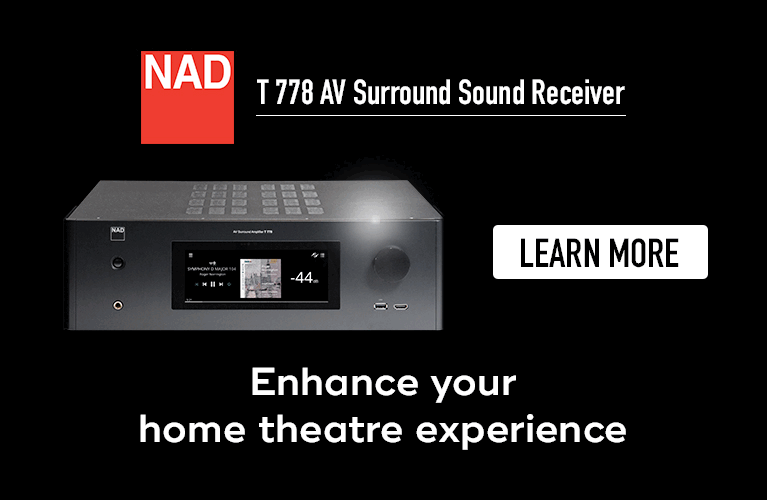Note: Measurements can be found through this link.
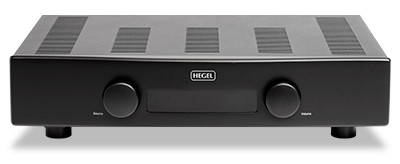 Hegel Music Systems makes high-quality, reasonably priced audio gear, including several recent DACs and amplification components that have been well received. In fact, Hans Wetzel so much liked the Norwegian company’s flagship integrated amplifier-DAC, the H300, that he bought the review sample. While the H300 retails for $5500 USD, it seems an excellent value, based on Hans’s review and my conversations with him.
Hegel Music Systems makes high-quality, reasonably priced audio gear, including several recent DACs and amplification components that have been well received. In fact, Hans Wetzel so much liked the Norwegian company’s flagship integrated amplifier-DAC, the H300, that he bought the review sample. While the H300 retails for $5500 USD, it seems an excellent value, based on Hans’s review and my conversations with him.
Hegel’s newest integrated-DAC, the H80, replaces the H70. At $2000, the H80 is Hegel’s least expensive integrated-DAC, but it’s claimed to include features from some of their more expensive models. Although these days I review a lot of home-theater components, there’s nothing I enjoy more than discovering and listening to affordable, high-quality two-channel gear. So when Jeff Fritz asked if I was interested in reviewing the Hegel H80, I agreed.
Description
The H80 measures 16.93”W x 3.94”H x 13.80”D and weighs some 20 pounds, much of that weight claimed by its substantial toroidal transformer, visible through the vents in its top panel. Those familiar with Hegel’s products will immediately recognize the H80’s styling. It looks like a smaller version of their other integrated amplifiers -- not a bad thing. The front panel curves gently outward and has softly rounded edges, giving it a nicely sculpted look. The large, rounded knobs for volume and source selection only enhance the sleek, minimalist look, which I found quite pleasing. The central, seven-character display has large, soft-blue letters and numbers that are easy to read. The power button is on the bottom plate, near the front left corner. Although I couldn’t see it, it was easy to find and press -- much more convenient than components with switches on their rear panels.
That rear panel sports a single pair of high-quality speaker binding posts, a pair of balanced analog inputs, and two pairs of single-ended analog inputs, one of them configurable as a home-theater-direct input (this is an internal modification done by your dealer). Because the H80 includes a DAC, it has S/PDIF inputs on two coaxial RCA jacks and two optical inputs, as well as a Type B USB input. The USB input is adaptive rather than asynchronous, as Hegel has developed their own elaborate reclocking system that uses a buffer and a precise proprietary clock that they believe does a better job of rejecting jitter than do most USB receiver chips in asynchronous mode. The DAC circuitry is said to be similar to that in their HD11 standalone DAC, but uses Texas Instruments’ PCM1754 chip rather than the AKM chip found in the HD11.
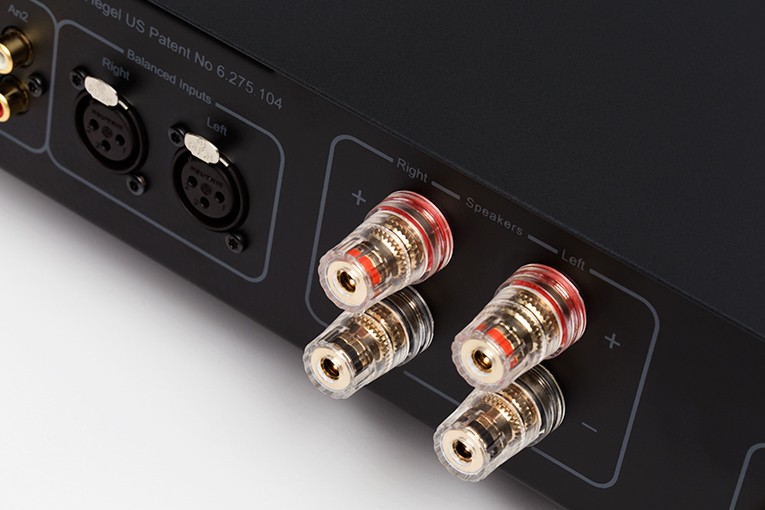
The USB input accepts digital data of resolutions up to 24-bit/96kHz, but won’t accept a sampling frequency of 88.2kHz. The H80 is not unique in this regard; for example, the NuForce DDA-100, which I recently reviewed, has the same limitation. I remedied the situation by setting the DSP on my media player to output 96kHz data, but this could be problematic if you have lots of 88.2kHz files and are playing them from, say, an optical disc player that lacks sample-rate conversion. The S/PDIF inputs accept sampling frequencies up to 192kHz, including 88.2 and 176.4kHz.
The H80 has the same very-high-quality preamplifier section found in the H300 integrated; apart from the gain stage, this preamplifier section is said to be the same as that found in Hegel’s P20 standalone preamp. And, like all Hegel amps, the H80 uses their patented SoundEngine technology, which is claimed to have a very high damping factor, and to greatly reduce distortion while using no global negative feedback. A class-A/B design rated to deliver 75Wpc into 8 ohms, it ran quite cool, even when I drove it to high volume levels.
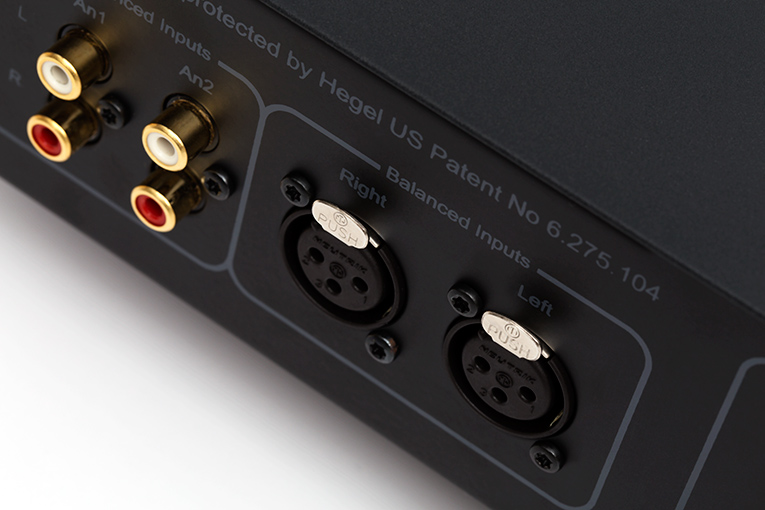
Hegel is unlike most other manufacturers these days in using in the H80 an older TI DAC chip and adaptive USB input. They do this, they say, because they’ve found that their design sounds and measures better. However, they don’t put their faith in any single type of design. For example, when they found that the USB receiver chip in their top-of-the-line DAC, the HD25, performed better in asynchronous mode with their proprietary reclocking system, they took the asynchronous route. This indicates to me that Hegel designs products for the best possible performance at a given price point, and doesn’t make design judgments based on preconceptions or marketing hype. I like that. I’ve always believed that it isn’t a particular technology or design methodology that makes one product superior to another. Rather, it’s how that technology is implemented that determines the quality of the end result.
One thing I didn’t like about the H80 was its tiny plastic remote control, with its thin, membrane-covered buttons. It’s the sort of remote I’d expect to see with a powered Bluetooth speaker system or soundbar, not a $2000 integrated amplifier.
Simple setup
I used the H80 primarily as an integrated amplifier-DAC. Via its USB input, it accepted signals from my Acer Aspire One 722 computer running foobar2000, but I also used its S/PDIF digital input with an Oppo BDP-105 universal Blu-ray player. The speakers I mostly used for this review were KEF’s R900s, but the Hegel also spent time with Definitive Technology’s Mythos ST-Ls and StudioMonitor 45s. Ancillary gear consisted of my usual assortment of Analysis Plus, DH Labs, and AudioQuest cables, ESP power cords, and Blue Circle Audio and Zero Surge power conditioners.
Sound
The H80’s 75Wpc made the Definitive Technology StudioMonitor 45s sound as good as they’ve ever sounded in my system, and it had plenty of headroom to drive the KEF R900s cleanly to volume levels that some might consider excessive. The high-resolution download of ZZ Top’s Eliminator (24-bit/192kHz FLAC, Warner Bros./HDtracks) is an improvement over the CD, but still far from what I’d consider an audiophile recording. Even so, the H80 had enough control that the snare drum was somewhat indistinct, as it should be, but not so much that it sounded like undifferentiated noise; there was a snap to the kick drum; and individual tom toms could be discerned in the drum rolls in “Sharp Dressed Man.”
With true hi-rez, reference-quality recordings, such as those from the 2L label, the R900s sounded pristine driven by the H80. Doug Schneider calls Ola Gjeilo’s Stone Rose (24/96 FLAC, 2L/HDtracks) one of the best-sounding recordings of an acoustic piano around, and I agree. With the H80 I could hear the sharp tone as the hammers strike the strings, followed by the warm, solid resonance of the piano itself. But this recording also includes a beautifully recorded violin throughout, and, in “North Country II,” a flugelhorn that was captivating in its precision. The H80 captured the subdued mood of the performance, the horn sounding more like a whispered breath. It quivered gently during its opening notes, then took on the more forceful sound normally associated with a brass instrument. It was placed precisely in the center of the soundstage, amid the larger, more diffuse images of the piano and violin, and maintained its image specificity.
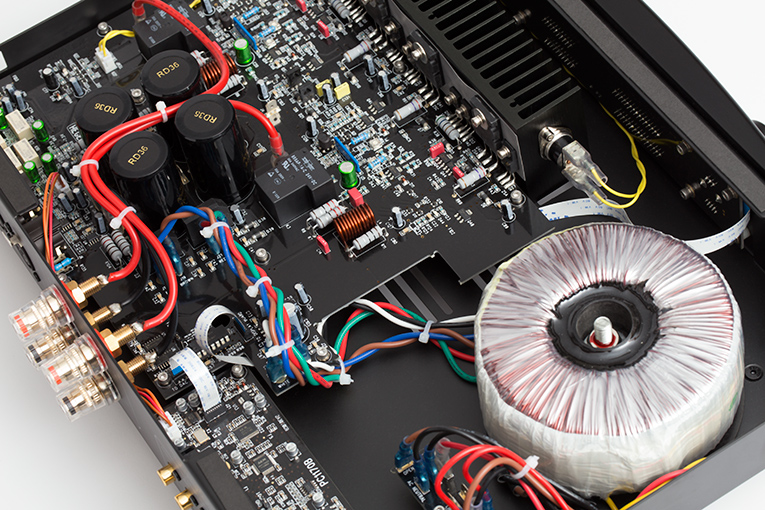
Bruce Cockburn’s voice in “Pacing the Cage,” from his The Charity of Night (16/44.1 FLAC, Rykodisc), was a little forward but solidly in the center of the soundstage. The H80 preserved the vulnerability of Cockburn’s performance as his voice trembled slightly and his twangy guitar, slightly to his left, had immediacy and clarity. Recordings of electric basses can often sound blurred, but Rob Wasserman’s bass in this track was uncommonly controlled, each note precisely articulated.
The powerful little Hegel took command of the KEF R900s with recordings that contain deep bass, such as Lorde’s Pure Heroine (24/48 FLAC, Lava Music/Republic/HDtracks). The melodic low frequencies in “Tennis Court” were nicely textured, giving the song a flowing, organic quality as the amp allowed the speakers to convey the bass’s subtle changes in pitch. The profoundly deep, powerful bass in “Royals” shook my room but remained controlled. The H80 did not lack for slam.
The Hegel’s ultraclean, slightly forward sound benefited Buddy Holly’s From the Original Master Tapes, making these recordings, now nearly 60 years old, sound fresh and lively. The percussion provided by Jerry Allison slapping his hands on his thighs in “Everyday” had a crisp character, and the celeste was appropriately metallic and sparklingly clear. Although the H80’s sound was crystalline and uncolored, it still sounded appropriately smooth with the voices and strings in “True Love Ways.”
When I compared the H80 to my budget reference amplification system, an Oppo BDP-105 ($1199) used as both a DAC and preamp and an Axiom ADA-1000 power amplifier ($1340, five-channel version), I heard some differences. The Hegel was generally more detailed and precise, but the Oppo-Axiom combo had a richer sound and could play louder. For instance, with ZZ Top’s “Sharp Dressed Man,” the Hegel presented a cleaner, more distinct image of Billy Gibbons’s electric guitar, which is often lost in the swishing of the snare drum, and the pulsing bass guitar and kick drum had more punch. The flugelhorn in Ola Gjeilo’s “North Country II” was glossed over slightly by the Oppo-Axiom combo, the quivering quality sounding more homogeneous, more like a single tone. However, when pushed hard, the H80 began to compress, and though the bass wasn’t quite as tight with the Oppo-Axiom, it was subjectively deeper.
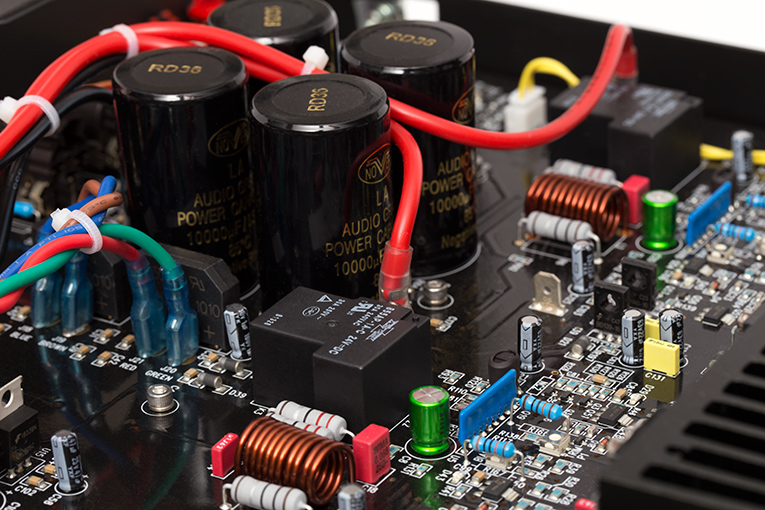
The clear sound of the H80 was equaled by that of my Anthem D2 A/V processor ($7500, discontinued) and Bel Canto e.One REF1000 power amplifiers ($3990/pair, discontinued). But my reference amplification system also threw a deeper soundstage, and in comparison, the H80 sounded a bit lean -- forgivable, considering that its $2000 price is only a fraction of the cost of my reference system. For example, with the Hegel the kick drum in the alternate take of “Burning Down the House,” from the DualDisc version of the Talking Heads’ Speaking in Tongues (16/44.1 FLAC, Warner Bros.), was tight, and imaging was excellent from left to right -- but the Bel Canto and Anthem had greater depth, and voices sounded richer and more full bodied. And even though his voice sounded richer through the Bel Canto and Anthem, in “Girlfriend Is Better” David Byrne’s singing still had that realistic, pitchy quality that conveys his nervous energy.
My Anthem Statement D2 A/V processor and Bel Canto e.One REF1000 amplifiers sound wonderful together, as they should, considering their price. The D2 also has the advantage of having Anthem’s proprietary ARC room-correction system built in. I didn’t use ARC for this review, but it makes my system sound even better, even though it takes almost half an hour to make the necessary measurements for five channels and upload the settings from my relatively slow computer. The D2 has all kinds of additional setup flexibility that I appreciate, but that requires more effort to use. It also requires more interconnects, to connect to the Bel Canto power amplifiers and to an external USB-to-S/PDIF converter to play music files from my computer. It’s not exactly the most user-friendly system.
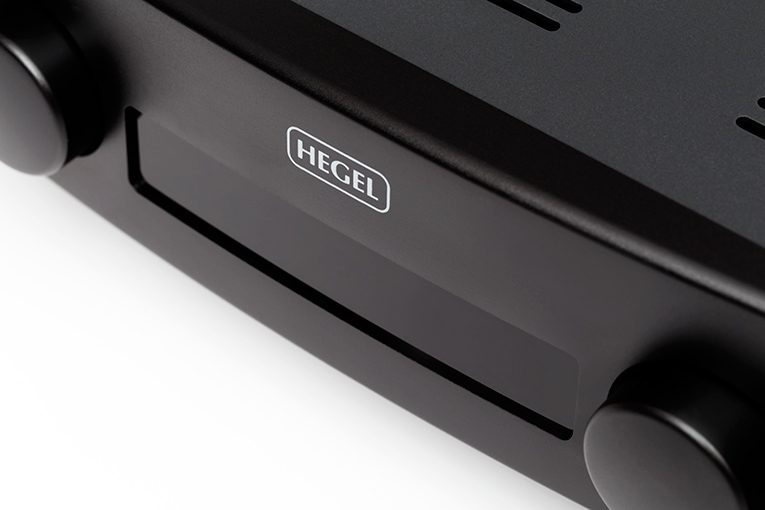
The Hegel H80 provided much more of a plug’n’play experience -- I had the system hooked up to my computer and playing audio files in a matter of minutes, with only a single USB cable required. The only drawback was that I had to set the media player to convert the sampling frequency of 88.2kHz files, as well as files with sampling rates higher than 96kHz, so that the H80 could recognize them through the USB input.
Conclusion
I found the Hegel H80 to be well built and well thought out; it performed superbly, no matter which speakers I used or what type of music I played. And maybe it’s because I spend so much time fussing with complicated multichannel audio equipment, but I found something that’s as simple to use and that sounds as good as the Hegel Music Systems H80 a refreshing change. Its clean sound and ability to play loud make it suitable for use in a high-performance system with any reasonable, moderately sensitive loudspeaker, and its solid build quality and glitch-free operation instil confidence. For $2000, the H80 is a great option for anyone looking for a cost-effective, single-box way to build a high-performance audio system.
. . . Roger Kanno
rogerk@soundstagenetwork.com
Associated Equipment
- Speakers -- Definitive Technology Mythos ST-L, Definitive Technology StudioMonitor 45, KEF R900
- Amplifiers -- Axiom Audio ADA-1000, Bel Canto Design e.One REF1000
- A/V processor -- Anthem Statement D2
- Sources -- Oppo BDP-105 universal BD player, Asus Aspire One 722 computer running Windows 7 and foobar2000, Bel Canto Design mLink USB converter
- Cables -- Analysis Plus Solo Crystal Oval interconnects and Black Oval 9 speaker cable, DH Labs Silver Sonic DV-75 digital interconnect, AudioQuest Carbon USB cable
- Power cords -- Essential Sound Products MusicCord-Pro ES
- Power conditioners -- Blue Circle Audio Peed Al Sea Thingee, Zero Surge 1MOD15WI
Hegel Music Systems H80 Integrated Amplifier-DAC
Price: $2000 USD.
Warranty: Three years parts and labor.
Hegel Music Systems AS
P.O. Box 2, Torshov
NO-0412 Oslo
Norway
Phone: +47 22-60-56-60
Fax: +47 22-69-91-56
E-mail: info@hegel.com
Website: www.hegel.com
North American distributors:
USA
Hegel Music Systems USA
Framingham, MA
Phone: (508) 405-0910
Fax: (508) 561-6109
E-mail: usa@hegel.com
Website: www.hegel.com
Canada
VMAX Services
CP 8, 1217 Greene Ave.
Montreal, Quebec H3Z 2T1
Phone: (541) 931-1880
Fax: (541) 931-8891
E-mail: info@vmax-services.com
Website: www.vmax-services.com






















